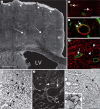Aquaporins in cerebrovascular disease: a target for treatment of brain edema?
- PMID: 21487216
- PMCID: PMC3085520
- DOI: 10.1159/000324328
Aquaporins in cerebrovascular disease: a target for treatment of brain edema?
Abstract
In cerebrovascular disease, edema formation is frequently observed within the first 7 days and is characterized by molecular and cellular changes in the neurovascular unit. The presence of water channels, aquaporins (AQPs), within the neurovascular unit has led to intensive research in understanding the underlying roles of each of the AQPs under normal conditions and in different diseases. In this review, we summarize some of the recent knowledge on AQPs, focusing on AQP4, the most abundant AQP in the central nervous system. Several experimental models illustrate that AQPs have dual, complex regulatory roles in edema formation and resolution. To date, no specific therapeutic agents have been developed to inhibit water flux through these channels. However, experimental results strongly suggest that this is an important area for future investigation. In fact, early inhibition of water channels may have positive effects in the prevention of edema formation. At later time points during the course of disease, AQP is important for the clearance of water from the brain into blood vessels. Thus, AQPs, and in particular AQP4, have important roles in the resolution of edema after brain injury. The function of these water channel proteins makes them an excellent therapeutic target.
Copyright © 2011 S. Karger AG, Basel.
Figures





References
-
- Klatzo I. Brain oedema following brain ischaemia and the influence of therapy. Br J Anaesth. 1985;57:18–22. - PubMed
-
- Gonen T, Walz T. The structure of aquaporins. Q Rev Biophys. 2006;39:361–396. - PubMed
-
- Yu J, Yool AJ, Schulten K, Tajkhorshid E. Mechanism of gating and ion conductivity of a possible tetrameric pore in aquaporin-1. Structure. 2006;14:1411–1423. - PubMed
Publication types
MeSH terms
Substances
Grants and funding
LinkOut - more resources
Full Text Sources

